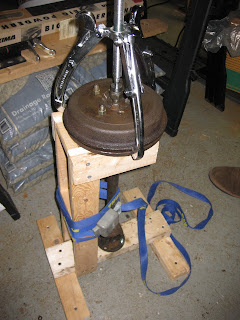Back when I went through a shopping spree of new car parts, I had purchased wheel bearings assuming the wheel bearings on the Triumph needed to be replaced. It turns out they didn't.
The bearings were in rather good shape, but I figured since I had bearings that were 40 years younger than those currently on the car, I might as well change them. In hindsight, I should have just left the bearings (more trouble for something that was fine), but for posterity, below is how I replaced the bearings.
Removing the bearing race was easy as it could be tapped out, but installing new bearings was a bit of a pain. At first, I tapped as far as it would go in with a scrap piece of 2x4 and hammer, but since the bearing race sits below the face of the hub, I needed something to tap it even further. I tried using the old bearing to help hammer the race in even further, but I found this left the slightest scuffs on the race where the rollers on the bearings were.

I found bearing installers online but they were 50-plus dollars, so I checked with AutoZone, but they did not carry any bearing installers in their loan-a-tool program. For bicycles, Chris had used quick-release hubs to install bearings on bike wheels and so we decided to build a homemade bearing race installer hub that functioned similarly to the quick-release hub.
I bought a long bolt, 2 nuts, and multiple sets of washers (I couldn't recall what size I needed to fit over the bearings properly - in actuality, you only need 2 washers) from Lowe's. The plan was to thread the bolt with a nut, followed by a washer of the correct size, followed by the old bearing, then the other side's old bearing, washer, and a nut. The idea was was to tighten the bolts and gradually squeeze the bearing races into place.
This setup worked really well. For less than $4, the bolt/nuts/washers pushed the races into place and did not leave any scuff marks on the races like the hammering method.
The picture below shows the setup on a hub. Two wrenches are needed - one to hold the back bolt in place and the other to tighten and squeeze the bolts closer together.

Next up...remove rust from the hub and stub axle carrier and paint.

















